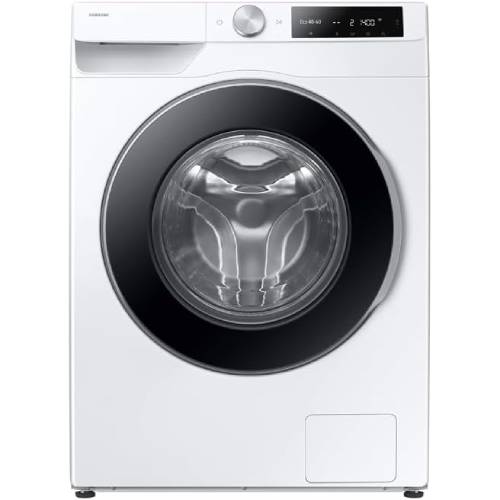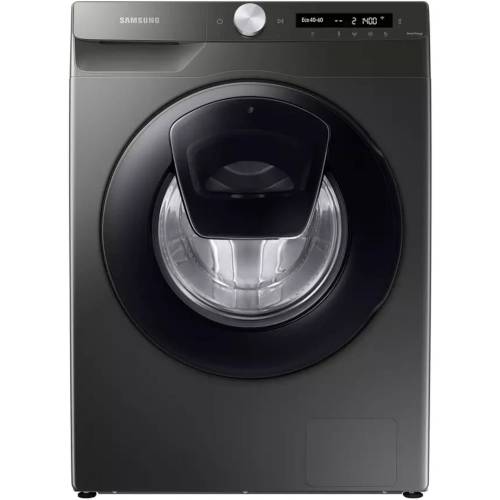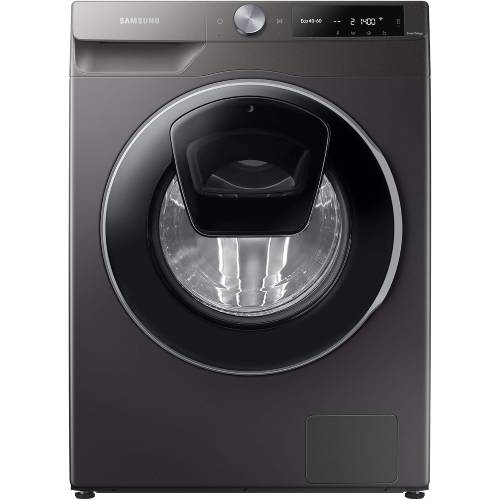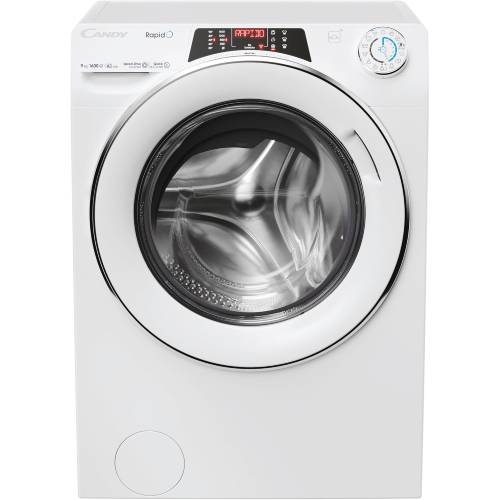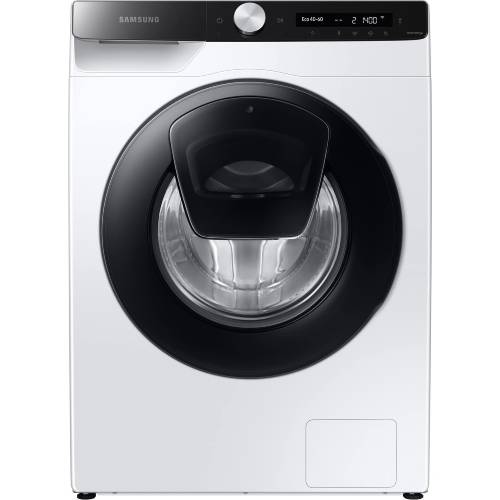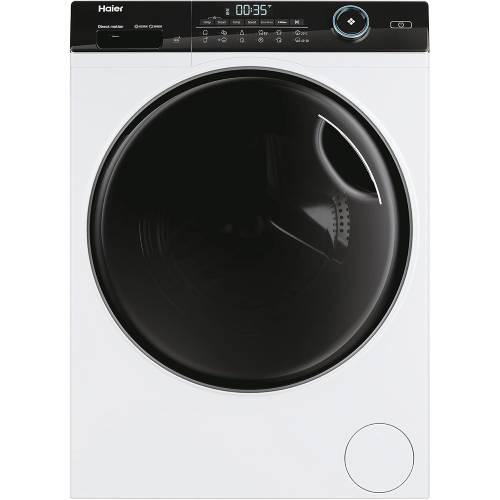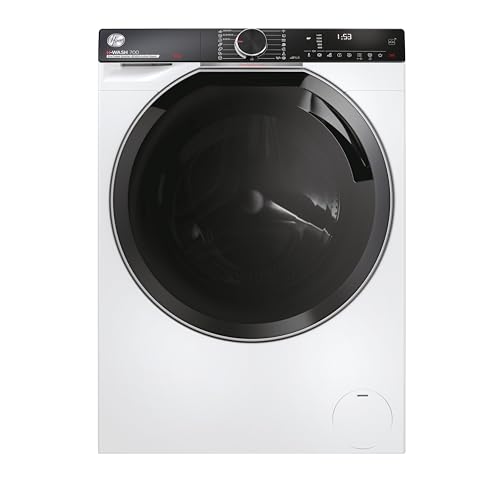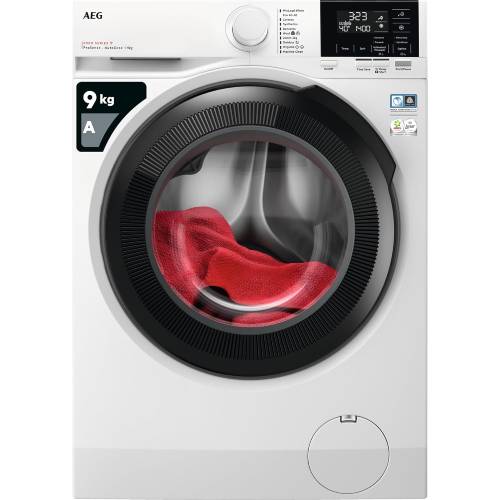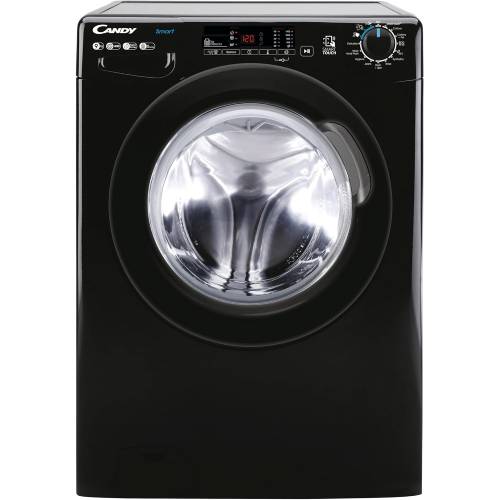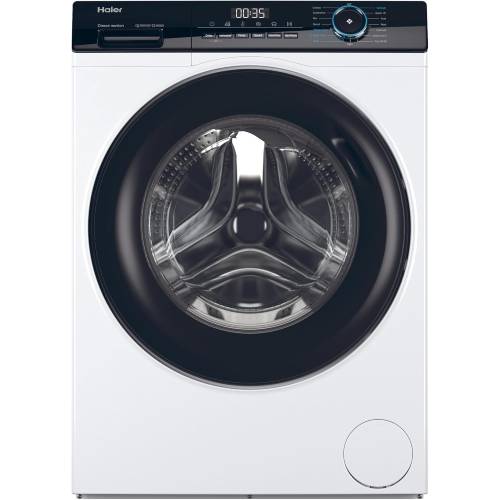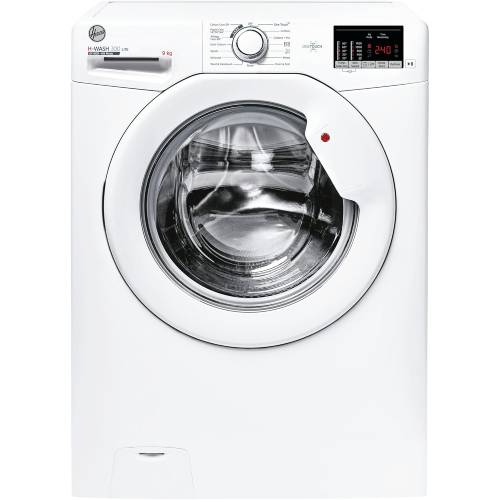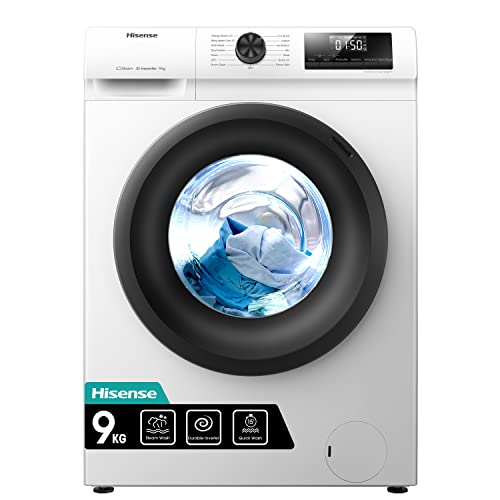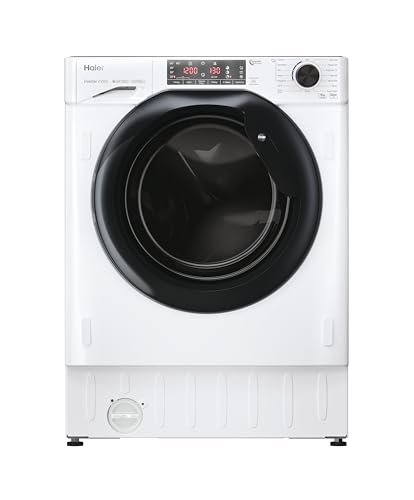Are 9 kg washing machines worth it?
9 kg washing machines achieve an overall score of 7.5 points, higher than the market average of 7.1 points. Their performance surpasses that of 10 kg washing machines (7.1 points), 8 kg machines (7.1 points), and 7 kg machines (6.6 points).
The average user rating for 9 kg washing machines is 8.3 points, higher than that of 7 kg (8.2 points) and 8 kg machines (7.9 points) but lower than 10 kg machines, which achieve 8.2 points.
Approximately 25% of washing machines on the market have a capacity of 9 kg.
How many clothes can a 9 kg washing machine hold?
A 9 kg washing machine can accommodate a variety of items, provided the total weight does not exceed 9 kg.
For example, a full load may include the following items with their approximate dry weight.
- Cotton t-shirts: Each weighs around 150-200 grams, so you can load approximately 40-45 t-shirts in one cycle.
- Jeans: Standard jeans weigh about 600-700 grams each, allowing for 11-13 pairs per load.
- Towels: A medium bath towel weighs about 500-600 grams, so you can wash 14-18 towels.
- Sweaters: Each sweater weighs about 400-500 grams, allowing for 16-20 sweaters per cycle.
- Socks: A pair of socks weighs around 50 grams, enabling up to 160-180 pairs in one load.
Factors such as fabric density, item size, and water absorption capacity affect the load capacity. Bulky items like blankets or jackets take up more space and weigh more when wet, reducing the number of items that can be washed together.
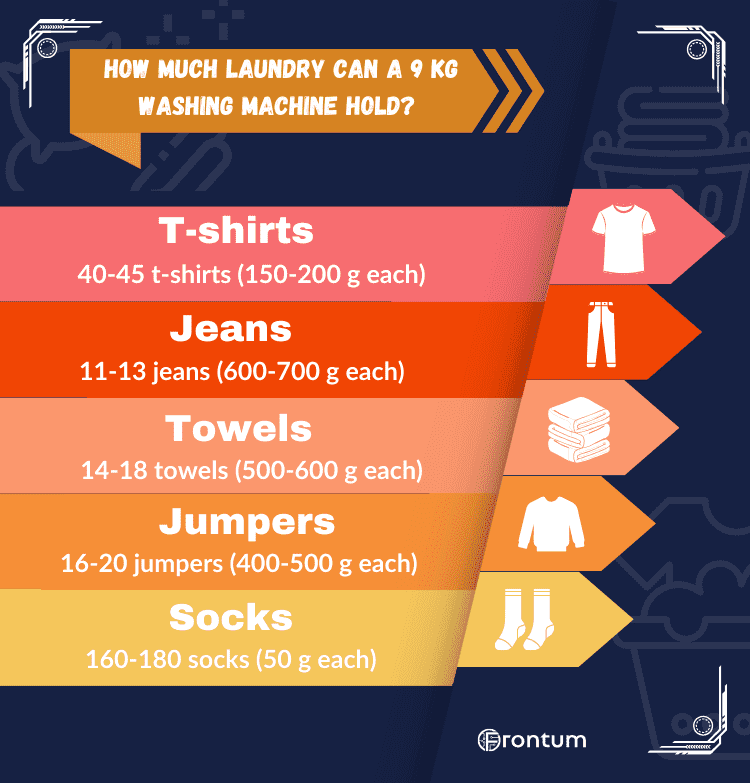
Washing machines perform best when loaded to optimal capacity. Overloading or underloading negatively impacts washing performance and machine lifespan. It is essential to leave about 10-15% of the drum volume empty to allow garments to move freely, ensuring effective washing and rinsing while avoiding excessive strain on the motor.
What are the main advantages of 9 kg washing machines compared to other capacities?
9 kg washing machines offer the following advantages over machines of other capacities.
- Wide availability: Approximately 25% of all washing machines on the market are 9 kg models.
- Availability of slim models: Some 9 kg washing machines feature slim designs.
- Good value for money: They have an average ratio quality/price of 7 points, despite higher prices.
- Higher user ratings: 9 kg washing machines receive an average user rating of 8.3 points, higher than the market average of 8.1.
- Inverter motor inclusion: 91% of 9 kg washing machines are equipped with an inverter motor.
- Larger drum volume: 9 kg models have an average drum volume of 61 litres, 6 litres more than the average washing machine.
- High energy efficiency: 9 kg washing machines consume about 49 kWh of energy per 100 cycles, the lowest among all capacities, with 69% in energy efficiency class A.
- Better water extraction: 88% of 9 kg models reach a maximum spin speed of 1400 rpm, and 8% reach 1600 rpm.
- Flexibility at low spin speeds: 74% of 9 kg washing machines can reach a minimum spin speed of 400 rpm for delicate garments.
- Quieter operation: 9 kg washing machines are 3 dB quieter during spin cycles (72 dB compared to 75 dB), with 56% in noise emission class A.
- Specialised washing cycles: Many 9 kg models feature cycles like Shirts, Duvets, Stain Removal, Jeans, Hygiene, Baby Care, or Outdoor/Sport, along with functions such as extra rinse, anti-crease, stain removal, quick wash, and prewash.
- Advanced features: Most 9 kg washing machines include laundry detection systems, foam control, unbalanced load detection, self-cleaning functions, steam technology, and special drum designs.
- Smart technology: Many 9 kg models offer features like load balancing systems, Wi-Fi connectivity, smart diagnosis, AquaStop system, pre-mix technology, automatic drawer cleaning, and automatic dosing systems.
- AI technology: Some 9 kg washing machines are equipped with AI technology.
What are the main disadvantages of 9 kg washing machines compared to other capacities?
The main disadvantages of 9 kg washing machines compared to other capacities are as follows.
- Higher cost: 9 kg washing machines have an average price of £100 more than the market average (£480 compared to £380).
- Limited model options: No top-loading models with a 9 kg capacity are available.
- Longer ECO cycle: The ECO cycle of a 9 kg washing machine takes about 10 minutes longer than the market average (228 minutes compared to 218 minutes).
- Larger footprint: 9 kg washing machines occupy more space, with an average volume of 0.295 m³, 18% more than, for example, 7 kg machines.
- Heavier weight: 9 kg washing machines have an average weight of approximately 69 kg.

How much do 9 kg washing machines cost?
A 9 kg washing machine costs between £300 and £1400, with an average price of around £480. These models are more expensive than washing machines with other capacities. For comparison, a 7 kg washing machine has an average cost of about £330, while an 8 kg machine is around £370.
The following chart shows the price distribution of 9 kg washing machines.
[vertical-chart-62139167]
The following washing machines are the most affordable 9 kg models.
- Comfee CFE12EW90/W (~£250)
- Hoover H-WASH 300 LITE H3W49TE (~£280)
- Candy Smart CS149TWBB4/1-80 (~£290)
Despite the higher price, 9 kg washing machines have a ratio quality/price of 7 points, in line with the market average.
The 9 kg washing machines offering the best value for money are as follows:
- Candy Smart CS149TWBB4/1-80 (Ratio quality/price: 7.77 points)
- Candy RapidÓ RO 1696DWMC7/1-80 (Ratio quality/price: 7.7 points)
- Hoover H-WASH 700 H7W449AMBC-S (Ratio quality/price: 7.62 points)
What are the best brands of 9 kg washing machines?
The best brands of 9 kg washing machines are as follows.
- Samsung (Average overall score: 8.2 points)
- Miele (Average overall score: 8 points)
- Bosch (Average overall score: 7.9 points)
The worst brands of 9 kg washing machines are as follows.
- SanGiorgio (Average overall score: 5.7 points)
- Whirlpool (Average overall score: 6.3 points)
- Hotpoint (Average overall score: 6.6 points)
The following chart compares 9 kg washing machine brands based on overall score.
[horizontal-chart-11987507]
Which 9 kg washing machine brands have the highest user ratings?
The 9 kg washing machine brands with the highest user ratings are as follows.
- Samsung (Average user rating: 8.8 points)
- Beko (Average user rating: 8.8 points)
- Siemens (Average user rating: 8.6 points)
The following chart ranks 9 kg washing machine brands based on user ratings.
[horizontal-chart-47187040]
What should you consider when choosing the best 9 kg washing machine?
When selecting the best 9 kg washing machine, consider factors such as energy consumption and energy efficiency class, water consumption, spin efficiency, noise levels during washing and spinning, motor type, available washing programs and functions, drum volume, and overall dimensions.
What is the energy efficiency of 9 kg washing machines?
9 kg washing machines are more energy-efficient than models with other capacities. 69% of these models are in energy class A, 13% in class B, 4% in class C, 13% in class D, and 1% in class E. In comparison, only 39% of washing machines on the market are in class A and 17% in class B, while the rest are distributed across classes C to G.
Energy classes reflect consumption: class A machines use less than 49 kWh per 100 cycles, while class B machines consume less than 55 kWh, with slight variations depending on capacity.
The following chart shows the distribution of energy classes among 9 kg washing machines.
[pie-chart-90494976]
9 kg washing machines consume between 40 and 90 kWh per 100 cycles, with an average of 49 kWh (6 kWh less than the market average). These machines use less energy compared to other capacities; for instance, 8 kg washing machines consume about 55 kWh, and 10 kg machines about 51 kWh per 100 cycles.
The chart below illustrates the distribution of energy consumption (per 100 cycles) for 9 kg washing machines.
[vertical-chart-19867946]
The most energy-efficient 9 kg washing machines are.
- Samsung WW90DG6U85LEU1 WW6400D (Energy consumption: 44 kWh/100 cycles per 100 cycles)
- Haier HW90-B14959U1 I-Pro Series 5 (Energy consumption: 49 kWh/100 cycles per 100 cycles)
- Hisense WFQA9014EVJM QA Serie (Energy consumption: 49 kWh/100 cycles per 100 cycles)
In terms of water consumption, 9 kg washing machines use between 42 and 51 litres per cycle, with an average of 49 litres, 3 litres more than the market average (46 litres per cycle). Water consumption increases with capacity: for example, 8 kg machines consume about 46.5 litres per cycle, while 10 kg machines use about 51 litres.
What Is the spin efficiency of 9 kg washing machines?
The spin efficiency of 9 kg washing machines falls into two main classes: class B (92% of these models) and class C (0%). Class B is the most common among all washing machine capacities, representing 85% of the market.
The chart below shows the distribution of spin-drying efficiency classes among 9 kg washing machines.
[pie-chart-37024508]
Spin-drying efficiency measures how well a washing machine removes water from clothes during spinning and is closely related to the maximum spin speed.
In 9 kg machines, maximum spin speeds range from 1200 to 1600 rpm, with 1400 rpm being the most common (78% of these machines), followed by 1200 rpm (12%). 9 kg washing machines tend to have higher maximum spin speeds compared to the market average, where only 68% of machines reach 1400 rpm.
Spin efficiency improves with higher speeds: at 1600 rpm, about 43% of moisture remains, at 1400 rpm 50%, and at 1200 rpm 53%. Higher speeds reduce drying times and energy consumption.
For those washing delicate items often, the minimum spin speed is also important. Lower speeds are ideal to avoid damaging delicate fabrics. In 9 kg machines, minimum spin speeds range from 400 to 800 rpm, with 97% of these machines achieving 400 rpm.
How noisy are 9 kg washing machines?
9 kg washing machines have spin noise levels ranging from 67 dB to 80 dB, with an average of 72 dB (3 dB quieter than the market average of 75 dB). The spin noise level measures the loudest phase of the washing cycle, making it the most reliable indicator of a washing machine's noise output.
Among 9 kg machines, the most common noise emission class is A (56%), followed by class B (22%).
Noise emission classes range from A to D: class A machines have noise levels below 73 dB, class B ranges from 73 to 76 dB, class C from 77 to 80 dB, and class D exceeds 80 dB.
The chart below illustrates the distribution of spin noise levels among 9 kg washing machines.
[vertical-chart-99510480]
If noise is a concern, also consider the noise level during washing. While less relevant than spin noise, wash noise levels for 9 kg machines range from 45 to 61 dB, with an average of 53 dB.
How many washing programs do 9 kg machines offer?
9 kg washing machines typically feature 10-24 washing programs, with an average of 16, one more than the market average. Most include 1 to 3 quick cycles lasting under an hour. ECO cycle durations range from 200 to 230 minutes, with an average of 228 minutes (10 minutes longer than the market average of 218 minutes).
The washing programs of 9 kg machines are similar to those of other capacities, with all models generally including basic programs such as Cotton, Eco 40-60, Synthetics, Quick Wash, Mixed Fabrics, Wool, and Prewash. However, they stand out for their specialised programs: 53% have a Jeans cycle, 48% a Duvet cycle, 73% a Hygiene cycle, 42% a Baby Care cycle, 76% an Outdoor cycle, 83% an Anti-Allergy cycle, and 52% a Shirts cycle.
The following chart shows the distribution of the number of washing programs in 9 kg washing machines.
[vertical-chart-16298753]
Many 9 kg machines include additional features such as extra rinse (91%), anti-crease (69%), stain removal (86%), quick wash (49%), and prewash (86%). Some models also offer features like a silent function (32%), soak option (27%), or Aqua+ function (12%).
What features do 9 kg washing machines have?
9 kg washing machines typically include 12 features, 2 more than the market average of 10 features.
The chart below shows the distribution of features in 9 kg washing machines.
[vertical-chart-66785338]
The most common features of these machines include laundry detection system (96%), foam control system (71%), unbalanced load detection (95%), self-cleaning function (79%), steam technology (73%), and special drum design (66%).
The most advanced 9 kg models may include features like load balancing system (38%), Wi-Fi connectivity (43%), smart diagnosis (61%), AquaStop system (35%), AI integration (21%), pre-mix technology (34%), automatic drawer cleaning (26%), and automatic dosing system (15%). Other advanced features include memory function (43%), energy-saving mode (32%), water jets system (22%), and eco indicator (27%).
91% of 9 kg washing machines are equipped with inverter motors, a higher percentage compared to the market average of 74%.
The 9 kg washing machines with the highest number of features are.
- Samsung WW90DG6U85LEU1 WW6400D (24 features)
- Hoover H-WASH 700 H7W449AMBC-S (23 features)
- Samsung WW90T684DLN WW6000T (23 features)
What is the drum volume of 9 kg washing machines?
The drum volume of 9 kg washing machines ranges from 54 to 68 litres, with an average of 61 litres (3 litres more than the market average of 58 litres). In comparison, 7 kg machines have an average drum volume of 48 litres, 8 kg machines have 55 litres, and 10 kg machines have 62 litres.
The chart below illustrates the distribution of drum volumes among 9 kg washing machines.
[vertical-chart-44081827]
The 9 kg washing machines with the largest drum volumes are.
- AEG LFR61944AD 6000 Series ProSense (Drum volume: 68.6 L)
- Zanussi ZWF942E3PW (Drum volume: 68.6 L)
- Haier HW90-B16939-UK I-Pro Serie 3 (Drum volume: 65 L)
How much space do 9 kg washing machines take up?
9 kg washing machines take up space ranging from 0.21 to 0.33 m³, with an average of 0.295 m³, about 5% more than 8 kg models (0.28 m³) and about 18% more than 7 kg models (approximately 0.25 m³).
The depth of 9 kg washing machines varies from 45 to 66 cm, so slim models are available. All 9 kg models have a width of approximately 60 cm.
The following are the most space-efficient 9 kg washing machines.
- Hisense WFQP9014EVM QPSerie (Volume: 226248.75 cm³)
- Midea MF10EW90BA (Volume: 240231.25 cm³)
- Haier HW90-B14959U1 I-Pro Series 5 (Volume: 255000 cm³)

